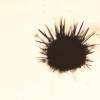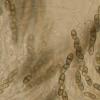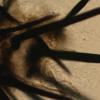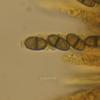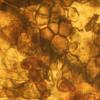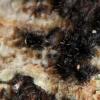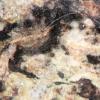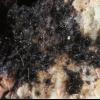
30-12-2025 16:44
Pascal DucosBonjour,Une anamorphe rose stipitée, très nombre

30-12-2025 17:14
 Bernard CLESSE
Bernard CLESSE
Bonjour à toutes et tous,Pourriez-vous aider Albe

29-12-2025 10:15
Hulda Caroline HolteHello, I found and collected this propoloid ascom

30-12-2025 09:04
Hello.A Pyrenomycete sprouting sparsely but very d

29-12-2025 17:44
Isabelle CharissouBonjour,J'aimerais savoir si d'autres personnes au

12-11-2021 00:03
Lepista ZacariasHi everybody,A week ago in my fiels trip I noticed

29-12-2025 17:12
 Bernard CLESSE
Bernard CLESSE
Bonjour à toutes et tous,Pourriez-vous m'aider à
Black, setose on Salix
Zuzana Sochorová (Egertová),
28-06-2022 22:07
 Hello,
Hello,I would welcome some help with these little ascomycetes growing on a fallen twig of Salix, accompanied by Diatrype bullata and Orbilia cf. tremulae. Czech Republic, 200 m a.s.l..
Black, globose, setose fruit bodies (that one in the photo is 280 µm broad).
Setae up to 170 µm long, pointed, black, thick-walled, base broadened.
The wall formed by t. angularis.
Asci 8-spored, IKI-, MLZ-.
Ascospores one-septate, each half containing a guttule, (7.1) 7.2-8.6 (8.9) × (3.1) 3.2-4.2 µm,
Q = 1.8-2.8
Me = 8 × 3.6 µm
I though it could be Capronia, and Gernot Friebes´s key from ascomycete.org led me to C. inconspicua. However, its ascospores should have a different shape. I was adviced by Bjorn Wergen Capronia isn´t the right genus for my fungus. Does somebody have an idea where could this asco belong to?
Zuzana
Hans-Otto Baral,
29-06-2022 08:05

Re : Black, setose on Salix
I think this is sordarial and a member of Lasiosphaeriaceae or Helminthosphaeriaceae. Perhaps related to Helminthosphaeria?
Alain GARDIENNET,
29-06-2022 09:25
Re : Black, setose on Salix
Surely.
Zuzana Sochorová (Egertová),
29-06-2022 20:46

Re : Black, setose on Salix
Thank you, Zotto and Alain.
Nevertheless, I tried to use the key to Helminthosphaeriaceae by Andrew Miller et al. 2014, but found no good option. I would come to the point 15, and then nothing is fitting. I also tried alternative ways, but it also didn´t bring any acceptable result.
Nevertheless, I tried to use the key to Helminthosphaeriaceae by Andrew Miller et al. 2014, but found no good option. I would come to the point 15, and then nothing is fitting. I also tried alternative ways, but it also didn´t bring any acceptable result.



